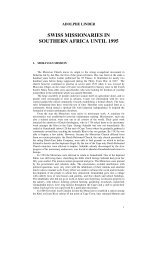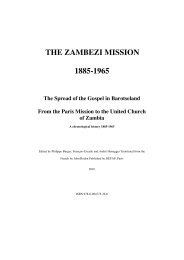THE SWISS IN SOUTHERN AFRICA 1652-1970 - swissroots-za.ch
THE SWISS IN SOUTHERN AFRICA 1652-1970 - swissroots-za.ch
THE SWISS IN SOUTHERN AFRICA 1652-1970 - swissroots-za.ch
Create successful ePaper yourself
Turn your PDF publications into a flip-book with our unique Google optimized e-Paper software.
Dut<strong>ch</strong> army. His grandson served as Aide-de-Camp to General Janssens, Governor of<br />
the Cape 1803-1806.<br />
On average 13 000 Swiss served at any one time in Swiss regiments in the<br />
Netherlands. Assuming ea<strong>ch</strong> gave nine years service, then over 103 years from 1693 to<br />
1795, 150 000 Swiss served in Swiss regiments in the Netherlands. In comparison the<br />
estimated 16 000 who served the VOC in its overseas territories, is very small. Swiss<br />
also emigrated to the Nerherlands to seek employment in the private sector. An example<br />
is Stucki, a bookkeeper of Obermeil ZH, who settled in Utre<strong>ch</strong>t. Two of his grandsons<br />
emigrated to South Africa, where one distinguished himself as a pioneer in the field of<br />
education.<br />
WHAT WERE <strong>THE</strong> ATTRACTIONS OF EMPLOYMENT BY <strong>THE</strong> VOC?<br />
Adventure: the <strong>ch</strong>ance of travelling to far away, exotic spice islands.<br />
Security: Permanent employment for a contract period of five years plus the travelling<br />
time. The contract could, on completion, be extended at increased pay. The pay could<br />
either be accumulated or transmitted home to support the family left behind.<br />
Good pay: Initially men were engaged as common soldiers on a monthly salary of nine<br />
florins (raised to fl 11 in the latter part of the eighteenth century) plus rations. However,<br />
there was the possibility of advancing to a better paid job. A carpenter or mason<br />
received fl 14 and a sergeant fl 18.<br />
/ 1 Rial: Die S<strong>ch</strong>weizeris<strong>ch</strong>en Regimenter in den Niederlanden; 2 Alba<strong>ch</strong>: Die<br />
S<strong>ch</strong>weizer Regimenter in holländis<strong>ch</strong>en Diensten.<br />
Various tables were compiled to facilitate the examination of the numbers of Swiss<br />
brought to the Cape by the VOC, their origins and, in broad outline, their a<strong>ch</strong>ievements.<br />
Table 4 (p. 14) shows the number of Swiss recorded at the Cape, their Canton of origin<br />
and the date of arrival. In the 143 years from <strong>1652</strong> to 1795 a total of 453 Swiss were<br />
recorded, not including the members of the Swiss Regiment Meuron brought to the<br />
Cape in 1783. Had no Muster Rolls had been missing, the total might well have<br />
exceeded 470. Canton Berne whi<strong>ch</strong> then included the Cantons of Vaud, Aargau and<br />
Jura, supplied the major portion of mercenaries for the Swiss regiments in Dut<strong>ch</strong><br />
service, and has the strongest representation amongst the Company servants, making up<br />
36,8%. Notable is the small but steady influx of men from Basel, while in proportion to<br />
its population, the largest number of men probably came from Appenzell. Few came<br />
from the catholic cantons. Overall the numbers show a growing tendency, the<br />
fluctuations peaking when the Cape was under threat of attack from the Fren<strong>ch</strong> during<br />
the War of Spanish Succession 1701-1714 and the War of Austrian Succession 1740-<br />
1748, and from the English during the American War of Independence 1776-1781.<br />
Table 5 (p. 16) analyses the activities of the Swiss stationed at the Cape. It shows that of<br />
the 453 Swiss recorded on Table 4 (p. 14), eighty were sick men left behind to recover<br />
before resuming their voyage to the East on other ships. Of the remaining 373, thirteen<br />
arrived as free settlers and 360 were stationed here as Company servants.<br />
Table 6 (p. 18) tabulates the Swiss according to the highest position attained at the<br />
Cape.<br />
HOW LARGE WAS <strong>THE</strong> PROPORTION OF <strong>SWISS</strong> <strong>IN</strong> <strong>THE</strong> COMPANY’S WORKFORCE?<br />
In Tabe 7 the number of Swiss at the Cape was determined every tenth year and<br />
compared with the total for all Company servants on that year’s Muster Roll. The<br />
weighted average works out to 1,6%. The Swiss thus formed one sixtieth of the<br />
Company’s workforce at the Cape. Using this figure some interesting guesstimates can<br />
be made. If the Swiss made up one sixtieth of the one million company servants<br />
transported overseas then 16 000 Swiss served in the Company’s overseas stations, of<br />
whom only 30% or 4 800 returned to Switzerland.<br />
15







